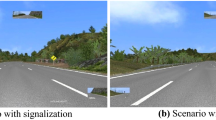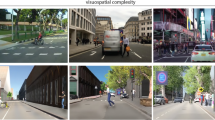Abstract
Driver fatigue is a common cause of car accidents. Thus, the objective detection of driver fatigue is a first step toward the effective management of fatigue-related traffic accidents. Here, we investigated the effects of driving time, a common inducer of driver fatigue, on the dynamics of fixational eye movements. Participants drove for 2 h in a virtual driving environment while we recorded their eye movements. Microsaccade velocities decreased with driving time, suggesting a potential effect of fatigue on microsaccades during driving.



Similar content being viewed by others
References
Ahlstrom C, Nyström M, Holmqvist K et al (2013) Fit-for-duty test for estimation of drivers’ sleepiness level: eye movements improve the sleep/wake predictor. Transp Res Part C Emerg Technol 26:20–32. doi:10.1016/j.trc.2012.07.008
Balkin TJ, Horrey WJ, Graeber RC et al (2011) The challenges and opportunities of technological approaches to fatigue management. Accid Anal Prev 43:565–572
Becker W, Fuchs AF (1969) Further properties of the human saccadic system: eye movements and correction saccades with and without visual fixation points. Vision Res 9:1247–1258. doi:10.1016/0042-6989(69)90112-6
Benedetto S, Pedrotti M, Bridgeman B (2011a) Microsaccades and exploratory saccades in a naturalistic environment. J Eye Mov Res 422:1–10
Benedetto S, Pedrotti M, Minin L et al (2011b) Driver workload and eye blink duration. Transp Res Part F Traffic Psychol Behav 14:199–208. doi:10.1016/j.trf.2010.12.001
Cerezuela GP, Tejero P, Chóliz M et al (2004) Wertheim’s hypothesis on “highway hypnosis”: empirical evidence from a study on motorway and conventional road driving. Accid Anal Prev 36:1045–1054. doi:10.1016/j.aap.2004.02.002
Citek K, Elmont AD, Jons CL et al (2011) Sleep deprivation does not mimic alcohol intoxication on field sobriety testing. J Forensic Sci 56:1170–1179. doi:10.1111/j.1556-4029.2011.01813.x
Dawson D (2012) Fatigue research in 2011: from the bench to practice. Accid Anal Prev 45(Suppl):1–5. doi:10.1016/j.aap.2011.09.016
Dawson D, Searle AK, Paterson JL (2013) Look before you (s)leep: evaluating the use of fatigue detection technologies within a fatigue risk management system for the road transport industry. Sleep Med Rev. doi:10.1016/j.smrv.2013.03.003
Di Stasi LL, Renner R, Staehr P et al (2010) Saccadic peak velocity sensitivity to variations in mental workload. Aviat Space Environ Med 81:413–417
Di Stasi LL, Antolí A, Cañas JJ (2011) Main sequence: an index for detecting mental workload variation in complex tasks. Appl Ergon 42:807–813. doi:10.1016/j.apergo.2011.01.003
Di Stasi LL, Renner R, Catena A et al (2012) Towards a driver fatigue test based on the saccadic main sequence: a partial validation by subjective report data. Transp Res Part C Emerg Technol 21:122–133. doi:10.1016/j.trc.2011.07.002
Di Stasi LL, Catena A, Cañas JJ et al (2013a) Saccadic velocity as an arousal index in naturalistic tasks. Neurosci Biobehav Rev 37:968–975. doi:10.1016/j.neubiorev.2013.03.011
Di Stasi LL, McCamy MB, Catena A et al (2013b) Microsaccade and drift dynamics reflect mental fatigue. Eur J Neurosci 38:2389–2398. doi:10.1111/ejn.12248
Di Stasi LL, Macknik SL, Martinez-Conde S (2013c) System and Method for using microsaccade peak velocity as a measure of mental workload and fatigue. Neurosci Biobehav Rev 37(5):968–975
Di Stasi LL, Cabestrero R, McCamy MB et al (2014a) Intersaccadic drift velocity is sensitive to short-term hypobaric hypoxia. Eur J Neurosci. doi:10.1111/ejn.12482
Di Stasi LL, McCamy MB, Macknik SL et al (2014b) Saccadic eye movement metrics reflect surgical residentsʼ fatigue. Ann Surg 259:824–829. doi:10.1097/SLA.0000000000000260
Engbert R, Kliegl R (2003) Microsaccades uncover the orientation of covert attention. Vision Res 43:1035–1045. doi:10.1016/S0042-6989(03)00084-1
Everling S, Pare M, Dorris MC, Munoz DP (1998) Comparison of the discharge characteristics of brain stem omnipause neurons and superior colliculus fixation neurons in monkey: implications for control of fixation and saccade behavior. J Neurophysiol 79:511
Evinger C, Manning KA, Sibony PA (1991) Eyelid movements. mechanisms and normal data. Invest Ophthalmol Vis Sci 32:387–400
Fletcher A, McCulloch K, Baulk SD, Dawson D (2005) Countermeasures to driver fatigue: a review of public awareness campaigns and legal approaches. Aust N Z J Public Health 29:471–476
FMCSA Federal Motor Carrier Safety Administration (2000) Hours of Service of Drivers; Driver rest and sleep for safe operations. Department of Transportation 49 CFR Parts 350, 390, 394, 395 and 398, Washington, DC
Fuchs AF, Kaneko CRS, Scudder CA (1985) Brainstem control of saccadic eye movements. Annu Rev Neurosci 8:307–337
Gancarz G, Grossberg S (1998) A neural model of the saccade generator in the reticular formation. Neural Netw 11:1159–1174. doi:10.1016/S0893-6080(98)00096-3
Gijsman HJ, van Gerven J, Verkes RJ et al (2002) Saccadic peak velocity and EEG as end-points for a serotonergic challenge test. Hum Psychopharmacol Clin Exp 17:83–89
Grossberg S, Kuperstein M (1986) Neural dynamics of adaptive sensory-motor control: ballistic eye movements. North Holland
Gruart A, Blázquez P, Delgado-García JM (1995) Kinematics of spontaneous, reflex, and conditioned eyelid movements in the alert cat. J Neurophysiol 74:226–248
Henn V, Lang W, Hepp K, Reisine H (1984) Experimental gaze palsies in monkeys and their relation to uman pathology. Brain 107:619–636. doi:10.1093/brain/107.2.619
Hirvonen K, Puttonen S, Gould K et al (2010) Improving the saccade peak velocity measurement for detecting fatigue. J Neurosci Methods 187:199–206. doi:10.1016/j.jneumeth.2010.01.010
Hockey GRJ (1997) Compensatory control in the regulation of human performance under stress and high workload: a cognitive-energetical framework. Biol Psychol 45:73–93
Klauer SG, Dingus TA, Neale VL et al (2006) The impact of driver inattention on near-crash/crash risk: an analysis using the 100-car naturalistic driving study data. DOT HS 810 594
Martinez-Conde S, Macknik SL, Hubel DH (2004) The role of fixational eye movements in visual perception. Nat Rev Neurosci 5:229–240
Martinez-Conde S, Macknik SL, Troncoso XG, Hubel DH (2009) Microsaccades: a neurophysiological analysis. Trends Neurosci 32:463–475. doi:10.1016/j.tins.2009.05.006
Martinez-Conde S, Otero-Millan J, Macknik SL (2013) The impact of microsaccades on vision: towards a unified theory of saccadic function. Nat Rev Neurosci 14:83–96. doi:10.1038/nrn3405
Maycock G (1997) Sleepiness and driving: the experience of U.K. car drivers. Accid Anal Prev 29:453–462. doi:10.1016/S0001-4575(97)00024-9
McCamy MB, Otero-Millan J, Macknik SL et al (2012) Microsaccadic efficacy and contribution to foveal and peripheral vision. J Neurosci 32:9194–9204. doi:10.1523/JNEUROSCI.0515-12.2012
McCamy MB, Otero-Millan J, Di Stasi LL et al (2014) Highly informative natural scene regions increase microsaccade production during visual scanning. J Neurosci 34:2956–2966. doi:10.1523/JNEUROSCI.4448-13.2014
McIntire LK, McKinley RA, Goodyear C, McIntire JP (2014) Detection of vigilance performance using eye blinks. Appl Ergon 45:354–362
Møller F, Laursen M, Tygesen J, Sjølie A (2002) Binocular quantification and characterization of microsaccades. Graefes Arch Clin Exp Ophthalmol 240:765–770. doi:10.1007/s00417-002-0519-2
Morris TL, Miller JC (1996) Electrooculographic and performance indices of fatigue during simulated flight. Biol Psychol 42:343–360. doi:10.1016/0301-0511(95)05166-X
Moschovakis AK (1994) Neural network simulations of the primate oculomotor system. Biol Cybern 70:291–302. doi:10.1007/BF00197610
Munoz DP, Dorris MC, Paré M, Everling S (2000) On your mark, get set: brainstem circuitry underlying saccadic initiation. Can J Physiol Pharmacol 78:934–944
Rahafrooz A, Fallah A, Jafari AH et al (2008) Saccadic and smooth pursuit eye movements: computational modeling of a common inhibitory mechanism in brainstem. Neurosci Lett 448:84–89. doi:10.1016/j.neulet.2008.10.019
Rubenzer SJ, Stevenson SB (2010) Horizontal gaze nystagmus: a review of vision science and application issues. J Forensic Sci 55:394–409. doi:10.1111/j.1556-4029.2009.01289.x
Schleicher R, Galley N, Briest S, Galley L (2008) Blinks and saccades as indicators of fatigue in sleepiness warnings: looking tired? Ergonomics 51:982–1010
Scudder CA (1988) A new local feedback model of the saccadic burst generator. J Neurophysiol 59:1455–1475
Shahly V, Berglund P, Coulouvrat C et al (2012) The associations of insomnia with costly workplace accidents and errors: results from the america insomnia survey. Arch Gen Psychiatry 69:1054–1063. doi:10.1001/archgenpsychiatry.2011.2188
Siegenthaler E, Costela FM, McCamy MB et al (2014) Task difficulty in mental arithmetic affects microsaccadic rates and magnitudes. Eur J Neurosci 39:287–294. doi:10.1111/ejn.12395
VOSA Vehicle and Operator Services Agency (2009) Rules on Drivers’ Hours and Tachographs: Passenger-Carrying Vehicles in the UK and Europe. Ref: 295667
Wertheim AH (1978) Explaining highway hypnosis: experimental evidence for the role of eye movements. Accid Anal Prev 10:111–129. doi:10.1016/0001-4575(78)90019-2
WMA (1964) Human Experimentation: code of ethics of WMA. Br Med J 2:177
Acknowledgements
This study was supported by the Barrow Neurological Foundation (to S.M.-C.), the National Science Foundation (awards 0852636 and 1153786 to S.M.-C), the Empire Innovation Program (to S.M.-C.), the Spanish Ministry of Economy and Finance (Projects PSI2012-39292 to A.C. and PSI2012-39246 to J.J.C.), the Deutsche Forschungsgemeinschaft (DFG, grant VE 192/17-1 to B.M.V.) and the Russian Science Foundation (grant 14-28-00234 to B.M.V.), the MEC-Fulbright Postdoctoral Fellowship program (grant PS-2010-0667 to L.L.D.S), and the Talentia Postdoctoral Fellowship program (grant Talentia Postdoc 267226 to L.L.D.S.). We thank the Spanish Dirección General de Tráfico (DGT) for supporting our research. Also, we would like to thank Jorge Otero-Millan, Stephen L. Macknik, Sven-Thomas Graupner, and Jens R. Helmert for helpful comments on earlier versions of the text. The authors have no conflicts of interest to declare.
Author information
Authors and Affiliations
Corresponding author
Additional information
Leandro L. Di Stas and Michael B. McCamy have contributed equally to this work.
Electronic supplementary material
Below is the link to the electronic supplementary material.
Rights and permissions
About this article
Cite this article
Di Stasi, L.L., McCamy, M.B., Pannasch, S. et al. Effects of driving time on microsaccadic dynamics. Exp Brain Res 233, 599–605 (2015). https://doi.org/10.1007/s00221-014-4139-y
Received:
Accepted:
Published:
Issue Date:
DOI: https://doi.org/10.1007/s00221-014-4139-y




